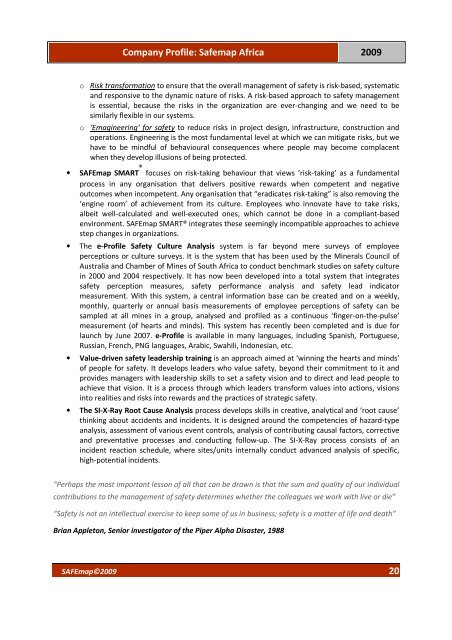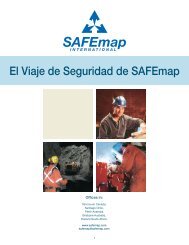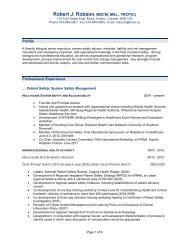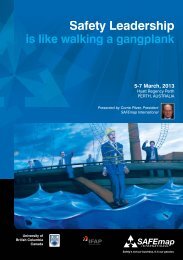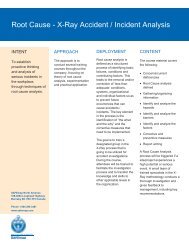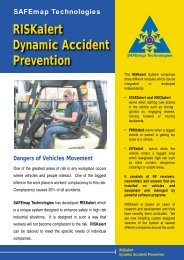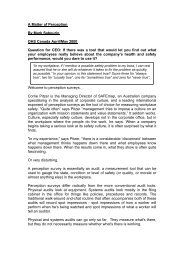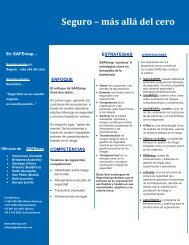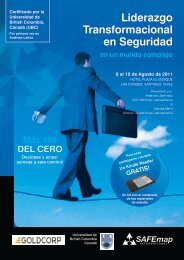Company Profile - SAFEmap International
Company Profile - SAFEmap International
Company Profile - SAFEmap International
You also want an ePaper? Increase the reach of your titles
YUMPU automatically turns print PDFs into web optimized ePapers that Google loves.
<strong>Company</strong> <strong>Profile</strong>: Safemap Africa 2009<br />
o Risk transformation to ensure that the overall management of safety is risk-based, systematic<br />
and responsive to the dynamic nature of risks. A risk-based approach to safety management<br />
is essential, because the risks in the organization are ever-changing and we need to be<br />
similarly flexible in our systems.<br />
o ‘Emagineering’ for safety to reduce risks in project design, infrastructure, construction and<br />
operations. Engineering is the most fundamental level at which we can mitigate risks, but we<br />
have to be mindful of behavioural consequences where people may become complacent<br />
when they develop illusions of being protected.<br />
• <strong>SAFEmap</strong> SMART ® focuses on risk-taking behaviour that views ‘risk-taking’ as a fundamental<br />
process in any organisation that delivers positive rewards when competent and negative<br />
outcomes when incompetent. Any organisation that “eradicates risk-taking” is also removing the<br />
‘engine room’ of achievement from its culture. Employees who innovate have to take risks,<br />
albeit well-calculated and well-executed ones, which cannot be done in a compliant-based<br />
environment. <strong>SAFEmap</strong> SMART® integrates these seemingly incompatible approaches to achieve<br />
step changes in organizations.<br />
• The e-<strong>Profile</strong> Safety Culture Analysis system is far beyond mere surveys of employee<br />
perceptions or culture surveys. It is the system that has been used by the Minerals Council of<br />
Australia and Chamber of Mines of South Africa to conduct benchmark studies on safety culture<br />
in 2000 and 2004 respectively. It has now been developed into a total system that integrates<br />
safety perception measures, safety performance analysis and safety lead indicator<br />
measurement. With this system, a central information base can be created and on a weekly,<br />
monthly, quarterly or annual basis measurements of employee perceptions of safety can be<br />
sampled at all mines in a group, analysed and profiled as a continuous ‘finger-on-the-pulse’<br />
measurement (of hearts and minds). This system has recently been completed and is due for<br />
launch by June 2007. e-<strong>Profile</strong> is available in many languages, including Spanish, Portuguese,<br />
Russian, French, PNG languages, Arabic, Swahili, Indonesian, etc.<br />
• Value-driven safety leadership training is an approach aimed at ‘winning the hearts and minds’<br />
of people for safety. It develops leaders who value safety, beyond their commitment to it and<br />
provides managers with leadership skills to set a safety vision and to direct and lead people to<br />
achieve that vision. It is a process through which leaders transform values into actions, visions<br />
into realities and risks into rewards and the practices of strategic safety.<br />
• The SI-X-Ray Root Cause Analysis process develops skills in creative, analytical and ‘root cause’<br />
thinking about accidents and incidents. It is designed around the competencies of hazard-type<br />
analysis, assessment of various event controls, analysis of contributing causal factors, corrective<br />
and preventative processes and conducting follow-up. The SI-X-Ray process consists of an<br />
incident reaction schedule, where sites/units internally conduct advanced analysis of specific,<br />
high-potential incidents.<br />
“Perhaps the most important lesson of all that can be drawn is that the sum and quality of our individual<br />
contributions to the management of safety determines whether the colleagues we work with live or die”<br />
“Safety is not an intellectual exercise to keep some of us in business; safety is a matter of life and death”<br />
Brian Appleton, Senior investigator of the Piper Alpha Disaster, 1988<br />
<strong>SAFEmap</strong>©2009 20


